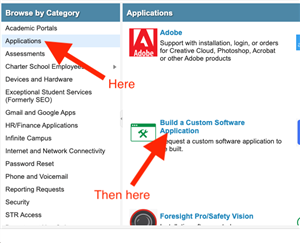-
Product & Process Team
-
Team Vision
We are a team of leaders. We lead projects, initiatives, implementations and lead by example.
We embody the DPS Core Values as well as our own shared team values of:
- Professional Ethics & Trust
- Work Ethic & Responsibility
- Growth & Development
- Teamwork & Social Responsibility
- Individuality & Independence
- Social & Emotional Wellbeing
-
What We Do (Our Mission)
Our primary function is to support Central Office teams and DoTS teams meet their business needs and objectives that support and align to the DPS Strategic Roadmap through:
- Strategic use and configuration of existing IT platforms and tools in the DPS ecosystem,
- Support in the identification of potential tools in the marketplace when existing ones aren’t capable, and
- When necessary, lead a custom software development effort to satisfy the business need(s).
The P&P Team has four main charges:
- Product Management, Intake, & Prioritization: Lead the intake, analysis, prioritization, and execution of Central Office and DoTS requests for an IT solution to a specific business problem or need. We also standardize the adoption and usage of the platforms Jira and Confluence.
- Business Analysis: Provide business analysis to various projects, efforts, and initiatives throughout the organization. As business analysts, we document requirements, analyze potential solutions for fit, and fill in other gaps as needed to ensure the business needs and objectives are met.
- Process Development & Adherence: Develop and implement processes for solution implementation & product management based on industry standards and best practices. Ensure adherence to those processes.
- Support Data Organization & Usage: Support the development and implementation of a cohesive strategy for the organization, analysis, and usage of data across our ecosystem of applications.
-
Who We Are
The Product & Process Team is comprised of Product Owners (PO) and Business Analysts (BA) responsible for analysis and documentation of potential IT projects, data-related requests and initiatives, other DoTS-only initiatives, and to function as the voice of the customer when executing those projects, requests, or initiatives. Our team also has a Jira & Confluence Product Manager who functions as a subject matter expert (SME) for these two platforms, and is responsible for the standardized implementation and usage of these tools.
-
Our Services
Reach out to the Product & Process Team if you…
- Have a business problem or initiative in need of an IT solution, but aren’t sure where to start,
- Want to request DoTS resources for a technology effort and you want to follow the correct process,
- Want to learn more about using Jira or Confluence for your team’s work,
- Have a specific data need, and are not sure where to start,
- Want to learn more about product management for your own team’s or department’s improvement,
- Are interested in having DoTS build you a custom software application,
Ready to get started? Fill out a DoTS intake request using the following instructions:
- Visit dotshelp.dpsk12.org and login with your DPS credentials.
- Under the "Browse by Category" section, click "Applications," and then select "Build a Custom Software Application."
- Fill out the form with all relevant information, scroll to the bottom and click "Save Incident."
NOTE: Use this form for all requests to the Product & Process Team; even if your request is not a custom software application.

-
Previous Projects and Upcoming Projects
Winter 2023 PI:
- Project(s) considered for PI Planning:
- MLE Letters in the Portals, MLE Department
- Transportation Driver Bids Tier 2, Transportation Department
- ECE Referrals Tracker, Student Equity and Opportunity
- DoTS Capacity: 300 Story Points
- Project(s) approved for implementation:
- Transportation Driver Bids Tier 2, Transportation Department
Winter 2022 PI:
- NOTE: Due to unforeseen loss of resources on the development team, DoTS has made the strategic decision to limit our capacity for this PI to 230 Story Points. We will not be considering additional projects for this PI.
- Jan. 17, 2022 - May 27, 2022: PI Execution
- DoTS Capacity:230 Story Points
- Project(s) approved for implementation:
- C&I - Summer Academy Backlog
- MLE - MLE Program Review Phase II
Fall 2021 PI:
- Project(s) considered for PI Planning:
- SEO - Assistive Technology Request Form
- C&I - Summer Academy Backlog
- MLE - MLE Program Review Phase II
- Academics, Ed Tech - See All Apps upgrades in Parent/Student Portal
- DoTS Capacity: 300 Story Points**
- Project(s) approved for implementation:
- SEO - Assistive Technology Request Form
- C&I - Summer Academy Backlog**
- MLE - MLE Program Review Phase II**
- Academics, Ed Tech - See All Apps upgrades in Parent/Student Portal
- **Shortly after approval of all four projects, DoTS had an unforeseen reduction in available capacity. Given the significant loss of capacity, some projects that were approved for implementation in Fall 2021, have been moved to Winter of 2022.
Winter 2021 PI:
- Project(s) considered for PI Planning:
- FACE - Mayor’s Student Youth Employment Program
- Research and Evaluation - Student Survey Opt Out Parent Tool
- College & Career Success - Student ICAP Tool
- DoTS Capacity: 175 Story Points
- Project(s) approved for implementation:
- Research and Evaluation - Student Survey Opt Out Parent Tool
- College & Career Success - Student ICAP Tool
Fall 2020 PI:
- Project(s) considered during PI Planning:
- TRIP Phase 2 (Transportation Department)
- ELA Program Review (ELA Department)
- DoTS Capacity: 200 story points
- Project(s) approved for implementation:
- ELA Program Review
-
Contact
Department of Technology Services (DoTS)
Emily Griffith Campus
1860 Lincoln St., 7th Floor
Denver, CO 80203













